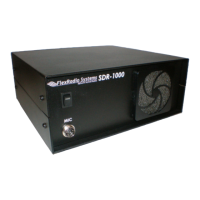S E T U P F O R M C H A P T E R 8
Rev. Paddles: Using this option will reverse the paddle inputs so that the dot becomes a dash and
vice versa.
High Res.: This option will attempt to further improve CW latency by using the high frequency
event timer (if present) on motherboards containing Intel Pentium 4+ (and AMD equivalent) type
processors. If the CW timing or tone production becomes unstable after checking the box, your
motherboard contains the low frequency timer and you should leave the box unchecked. The option
works for both manual and automatic CW.
Mode B: Check this box to enable Iambic mode B emulation. Uncheck it to enable mode A
emulation.
Signal Shaping
Figure 92: Signal Shaping Controls
Weight: Sets the width ratio between the dot and dash.
Ramp: Sets the length of the leading and trailing edge on the tones in milliseconds to avoid “key
clicks.”
Semi Break In
Figure 93: Internal Keyer Semi Break In Controls
Enabled: Check this box to enable Semi Break In for the internal keyer.
Delay (ms): Sets the amount of time between the last detected input and when the radio will drop
back to receive. The smallest possible setting is 150 ms and it is recommended that this be set larger
than 250ms. The SDR-1000 is not a QSK radio.
[The rest of this page has been left blank intentionally]
94 FlexRadio Systems

